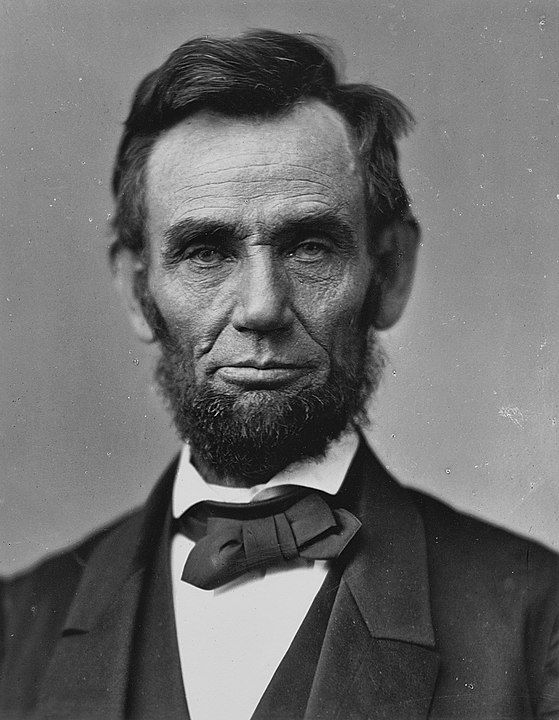Speech Analysis: Gettysburg Address
Abraham Lincoln
Gettysburg Address
Rhetorical Analysis presented by E. Ryan
Introduction
The Gettysburg Address, delivered by then President of the United States Abraham Lincoln on November 19, 1863 at the dedication of the Soldiers' National Cemetery in Gettysburg, Pennsylvania is considered one of the most important documents in American history. The 272 word speech has been remembered for its eloquent and inspiring words of patriotism, which sought to unify a war-torn nation.
I encourarge you to:
- Read the annotated transcript below
- As you do so, you can hover over any of the highlighted words/phrases in the transcript to see a brief explanation of the rhetorical devices and techniques used.
- Most of those annotations contain a link to see further information on the device/technique used.

museums.fivecolleges.edu, Public Domain, Link
Notes
Sometimes a phrase may contain more than one rhetorical device. When this happens, we do one of two things:
- we tag part of it, and use the tooltip to explain the full part of the phrase that demonstrates that device.
- we ignore it, on the basis that there are plenty other highlighted examples of the device used in the speech.
Annotated transcript
Fourscore and seven years ago Learn more. This is an allusion to the signing of the Declaration of Independence but it also echoes the archaic language of the Bible (Psalms 90:10) which describes a human lifespan as "threescore years and ten".
our
brought forth on this continent a new nation,
in liberty and dedicated to the proposition that all men are created equal Learn more. Here he is alluding to the U.S. Declaration of Independence..Now weLearn more. are engaged in a great civil war, testing whether
that nation or any nation so conceived and so dedicated Learn more. The phrase "that nation" multiplies to "any nation" while "so conceived" is parallel with "so dedicated"
can long endure. WeLearn more. are met on a great battlefield of that war. WeLearn more. have come to dedicate a portion of that field as a
final resting-place Learn more. It is a euphamistic way of saying they died here (7000+ died at Gettysburg).
for those who
hereLearn more.
gave their lives that that nation might live. Learn more.
It is altogether fitting and proper that we should do this.But, in a larger sense, we cannotLearn more.dedicate Learn more. The full phrase "we cannot dedicate" is part of a tricolon. , we cannot Learn more. consecrate Learn more. The full phrase "we cannot consecrate" is part of a tricolon. , Learn more. The word 'and' could have been used here.
we cannot Learn more.
hallow Learn more. The full phrase "we cannot hallow" is part of a tricolon. this ground. The brave men, living and dead Learn more. who struggled
hereLearn more.
have consecrated it far above our poor power to
add or detract. Learn more.
The
world Learn more.
will little note nor long remember what we say here, but it can never forget what they did here. Learn more. There are two sets of opposing ideas here: 'forget/remember' and 'say here/did here'.
It is for us the living rather to be dedicated
hereLearn more.
to the unfinished work which they who fought
hereLearn more.
have thus far so nobly advanced. It is rather for us to be
hereLearn more.
dedicated to the great task remaining before us --
thatLearn more. This 'anaphora' is the beginning of the first part of a tetracolon that takes us to the end of the speech.
from these honored dead
we take Learn more. First part of 'we take|they gave' combination.
increased devotion to that cause for which
they gave Learn more. Second part of 'we take|they gave' combination.
the last full measure of devotion Learn more. Another euphamistic way of saying they died.
--
thatLearn more. This 'anaphora' is the start of part 2 of a tetracolon that takes us to the end of the speech.
we
here Learn more.
highly resolve that these
dead Learn more. First part of 'dead|died' polyptoton
shall not have
diedLearn more. Second part of 'dead|died' polyptoton in vain;
thatLearn more. This 'anaphora' is the start of part 3 of a tetracolon that takes us to the end of the speech. this nation under God shall have a new
of freedom; and thatLearn more. This 'anaphora' is part 4 of a tetracolon that concludes the speech. government of the people, for the people, by the people Learn more. The repetition of 'the people' is also an example of epistrophe while the omission of an 'and' before the last repetition is an example of asyndeton. "The people" is also an allusion to the US Constitution whose preamble begins "We the people." shall not perish from the earth.Other observations
Aside of the rhetorical devices used in this speech, it is noteworthy for a number of other reasons:
- Lincoln starts the speech by alluding to the Bible and also the founding documents of the country. These are documents that the audience trust, which has the effect of making the audience more receptive to his message.
- The speech is built around a simple chronological structure:
- Past: the establishment of the republic
- Present: the Civil War which is underway
- Future: the 'new birth of freedom' that will come
- Another way of looking at the structure is as follows:
- Birth
- Death
- Rebirth
- Lincoln issues a 'call to action' near the end of the speech. He talks about how deeds will be remembered more than words, the 'great task remaining before us', our 'increased devotion to that cause' and the 'new birth of freedom'.
- Lincoln mentions God and alludes to the US Constitution in the last sentence of the speech. This mirrors the beginning of the speech, creating a pleasing symmetry.
- Lincoln uses inclusive language throughout the speech using phrases such as 'our fathers' and repeating the word 'we' ten times. He repeats the word 'nation' five times and never mentions the 'Union' or the 'Confederacy'. This is surprising given that he was there to dedicate an exclusively Union cemetery by delivering a war speech designed to rally his side in the conflict to stay the course.
- Lincoln provides each of the three types of proof/persuasive appeal identified by Aristotle:
- Ethos (credibility/ethics): by starting with a statement that his audience perceives to be true, with its allusions to the Bible and founding documents, Lincoln borrows the authority and credibility of those sources for the rest of his speech.
- Pathos (the appeal to emotion): Lincoln evokes emotion in his audience by addressing emotionally charged topics such as struggle, courage, death and the sacred. He makes the audience feel that they must continue the struggle for which many brave men were sacrificed.
- Logos (the appeal to reason): He builds a logical argument by speaking of why the nation was founded, what has been lost in trying to preserve it, and why it matters that the living must take up the unfinished work to ensure that it endures.
Further reading
The analysis presented above focuses on the rhetoroical devices used in the speech. There is a lot more to know about this speech that is not covered in detail here. Please see the content below.- Library of Congress exhibit on the Gettysburg Address Visit
- Course Hero infographic about the Gettysburg Address Visit
- American Rhetoric - includes audio performances of the Gettysburg Address Visit
- Wikipedia page on the Gettysburg Address Visit
- Diana Schaub's article in National Affairs: Lincoln at Gettysburg Visit
- Frank Coffman's article in Medium.com: A Rhetorical Analysis of Lincoln’s “Gettysburg Address” Visit
